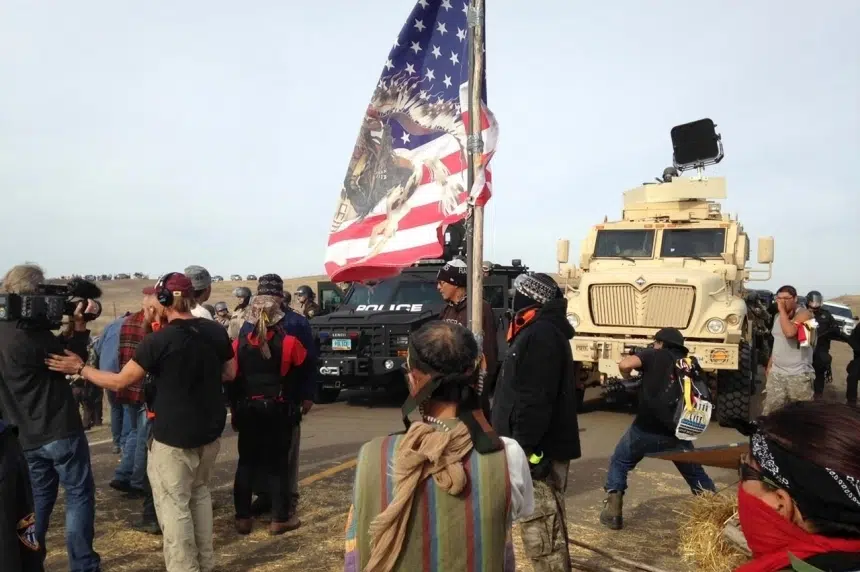CANNON BALL, N.D. — Law enforcement officers in riot gear and firing bean bags and pepper spray evicted protesters Thursday from private land in the path of the Dakota Access oil pipeline, dramatically escalating a dispute over Native American rights and the project’s environmental impact that has simmered for months.
In an operation that took nearly six hours, hundreds of armed state and local police and National Guard — some on foot and others in trucks, military Humvees and buses — pushed past burning barricades to slowly envelop the camp.
No serious injuries were reported, though one man was hurt in the leg and received treatment from a medic.
More than a dozen protesters who refused to leave were arrested and taken to the Morton County Jail, Sheriff Kyle Kirchmeier said.
He said that the camp had been cleared by nightfall although police were still dealing with protesters on the perimeter. Though officials earlier said they planned to turn the site over to private security, Kirchmeier said police would stay for now.
“We’re not leaving the area,” Kirchmeier said. “We are just going to make sure that we maintain a presence in the area so the roadway stays open, and to keep individuals from camping on private land.”
Opponents of the pipeline over the weekend set up camp on private land owned by Texas-based Energy Transfer Partners, which is working to complete the 1,200-mile pipeline to carry oil from western North Dakota to Illinois. The route skirts the Standing Rock Reservation and the tribe says it could endanger water supplies and disturb cultural sites. The state of North Dakota says no sensitive cultural sites have been found in the area.
The tribe has gone to court to challenge the U.S. Army Corps of Engineers’ decision granting permits at more than 200 water crossings. A federal judge in September denied their request to block construction, but three federal agencies stepped in to order construction to halt on Corps-owned land around Lake Oahe, a wide spot of the Missouri River, while the Corps reviewed its decision-making.
Construction was allowed to continue on private land owned by the developer, with a goal of completion by the end of the year.
Thursday’s operation to push out the protesters began a day after they had refused to leave voluntarily. Law enforcement repeatedly asked protesters to retreat, at one point using a high-pitched whistle they said was intended to “control and disperse” protesters.
The camp cleared on Thursday is located just to the north of a more permanent and larger encampment on federally owned land which has been the main staging area for hundreds of protesters, including Native Americans from across North America, environmentalists and some celebrities.
Many protesters openly defied the officers, while others took part in prayer circles and burned sage.
Cody Hall, a spokesman for the protesters, vowed a new camp would be built elsewhere in the pipeline’s path, but on federal land.
“It’s going to take a lot to move them (protesters) from there,” he said.
Authorities said protesters set fire to four large pieces of construction equipment. At least two cars were also burned.
Aaron Johnson, 50, a member of the Cheyenne River Sioux in South Dakota, said he and other protesters weren’t happy with the day’s outcome. “I came here for peace and prayer,” he said. “When somebody sets something on fire, that’s not peace and prayer.”
That has 45 youth in Saskatoon angry as they protested in front of City Hall Thursday afternoon.
Protestors at City Hall not happy with Dakota Access Pipeline @CKOMNews #yxe #cdnpoli pic.twitter.com/lLznjAwA3q
— JT Marshall (@jtmarshallCKOM) October 27, 2016
“I love the environment,” said 13-year-old Sam Edwards, who’s in Grade 8 at St. Edward School. “It’s protecting me, so I need to protect it.”
Edwards said oil should be kept in the ground and wants to see an end to the use of pipelines.
“What the hell is going on, I can’t stand oil or pipelines,” he said. “I believe oil should never have been taken out of the ground in
the first place and even if we did we should put it back.”
Some of the protest signs read: TD stop funding Dakota Access pipeline, water is life, and keep oil in the ground.
“If we have to pipeline oil we should do it in an area that’s not threatened,” said 13-year-old Lauren Konok, also in Grade 8 at St. Edward School. “We definitely shouldn’t do it under a river.”
The youth also face timed with protestors in North Dakota cheering them on.
___
Nicholson reported from Bismarck, North Dakota.
James MacPherson And Blake Nicholson, The Associated Press







